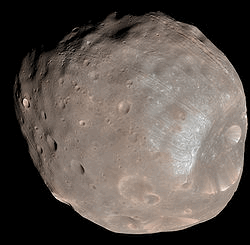Newly-confirmed Origin of Phobos has Discouraging
Implications for both Martian and Lunar Economies

Report and Commentary by Peter Kokh
2010.10.18 - On March 3, 2010, the European Space Agency's Mars Express orbiter, in a highly elliptical orbit, made its closest pass ever to Mars larger and innermost mini-moon Phobos. The craft was equipped to measure infinitesimal variations of its speed as it flew through Phobos' feeble gravitational field.
Now, as a result of six months of study of the Mars Express data, scientists have been able to confirm that Phobos was "formed relatively near its current location via re-accretion of material blasted into Mars's orbit by some catastrophic event," indeed, much as we think our own Moon was formed.
The implications of this origin apparently doom hopes that Phobos could become the initial foundation of a Mars frontier economy based on Moon-Mars System trade.
Why? The Mars Radio Science Experiment (MaRS) on board Mars Express has confirmed suspicions that Phobos is very "porous." Its low density fits a constitution of a loose pile of large rocks with substantial voids in between them, the whole loose pile covered with many meters of dust. A relatively slow impact could have created the proportionately large Stickney crater at one end of Phobos' potato-like shape. The implications as far as Phobos' mineralogy goes, is that Phobos is made of material once on Mars surface. And it is this fact that dashes the hopes of many that Phobos may have been a captured carbonaceous chondrite type asteroid fragment. For if that would have been true, Phobos could have become a virtual gold mine of hydrogen, carbon, and nitrogen, badly needed on the Moon to supplement the supplies of these volatiles that pioneers might be able to harvest from the solar wind particles adsorbed to fine moondust particles. Those volatiles could have been shipped in tankers from Phobos to the Moon, making the trasnit as easy to handle liquid methane CH4 and liquid ammonia NH3.
Phobos is high up Mars' gravity well. Thus, in terms of fuel expenditures, Phobos would have been the most economical source of supplemental supplies of these elements needed for lunar agriculture and biosphere support in general as well as manufacuting and other vital uses.
And that trade could have been the cornerstone of an "Economic Case for Mars." Unlike the Moon which is a potential source of building materials needed in Earth Orbit at a twentieth the fuel transportation cost of bringing similar materials up to orbit from Earth's nearby surface, Mars does not seem to be a source of anything it could market to Earth itself, other than tourist experiences (and how many would give up three years of their lives for a few months on Mars, when they could go to the Moon for a short visit almost anytime?)
For the Moon, this now means we need to prioritize the search for Near Earth Objects that might be of carbonaceous chondrite composition - most NEOs seem to be of the stoney type - and/or NEOs that might be the exhausted hulks of comets no longer outgassing long tails (most comets are in high inclination orbits, requiring considerable delta-V and fuel expenditure to reach.
For Mars, developing the Economic Case on which frontier settlement might be based, has long been tucked under the rug, never mentioned, mainly because there would seem to be nothing to go on. While Mars is more blessed than the Moon in terms of raw materials needed for industrial independence, it will take a long time to get to that level of economic self-sufficiency, and there will be a need to pay for the supplies needed to build the Martian economy up to that point. That Means Mars must prioritize production of materials and/or goods and/or services to the Earth-Moon system, in order to pay for these critical imports. Otherise, settling Mars as a viable second human world will remain a dream.
It is in the interest of both Moon and Mars-enthusiasts, then, that we painstakingly put together an Economic Case for Mars, as it would seem that both frontiers, lunar and Martian, might be more viable as trading partners, than either could be on its own. The things suggested so far (exotic gems, exotic perfumes and pharmaceuticals made from exotic Martian soils) have no foundation and just idle science-fantasy thinking - not even woth the adjective science-fiction. The Mars Society itself, as well as its several off shoots such as the Mars Foundation, have ignored the problem in hopes that it would solve itself.
The postponed Russian Phobos-Grunt missn will probably confirm the Mars Express findings and teach us much more about this small but strategically placed moonlet.
Meanwhile, Phobos and Deimos both have value as places from which fleets of robotic Mars surface rovers can be teleoperated at sub-second time delays. Currently, teleoperation from Earth involves a lengthy time-delay, from 6-40 minutes (compared to less than 3 seconds Earth><Moon.) Until we have sufficiently explored Mars to determine with confidence the best place to build a human beachhead, these moonlets offer a friendly (radiation shielding) forward human operations base.
The economic case for the Moon is fairly strong. We all need to work on the one for Mars. Lunar enthusiasts have a stong self-interest in taking the lead. - PK
Source: http://www.marsdaily.com/reports/Martian_Moon_Phobos_May_Have_Formed_by_Catastrophic_Blast_999.html
Our now outdated schematic of potential Earth-Moon-Mars triangle of trade
More reading: http://www.moonsociety.org/mars/ - with links to much more



